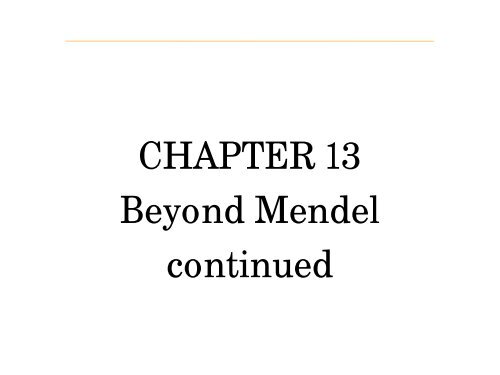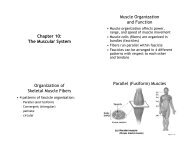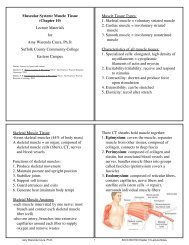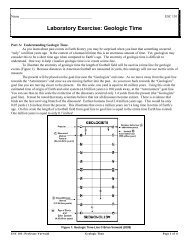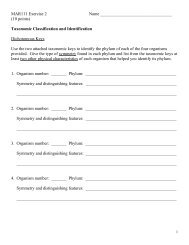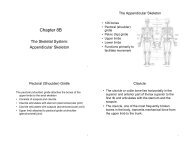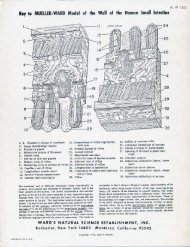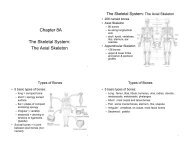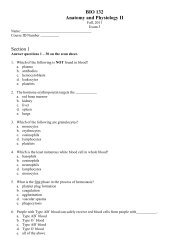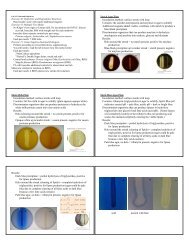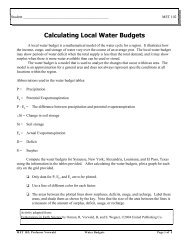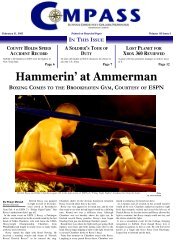CHAPTER 1 Genetics: An Introduction
CHAPTER 1 Genetics: An Introduction
CHAPTER 1 Genetics: An Introduction
Create successful ePaper yourself
Turn your PDF publications into a flip-book with our unique Google optimized e-Paper software.
<strong>CHAPTER</strong> 13<br />
Beyond Mendel<br />
continued
Modifications of Dominance<br />
Relationships<br />
• Incomplete dominance<br />
• Codominance
Gene Interactions and Modified<br />
Mendelian Ratios<br />
• Phenotypes result from complex interactions of<br />
molecules under genetic control. Using genetic analysis<br />
one can often detect the patterns of these interactions.<br />
For example:<br />
• a. In the dihybrid cross AaBb´ x AaBb, nine<br />
genotypes will result. If each allelic pair controls a<br />
distinct trait and exhibits complete dominance, a 9;3;3;1<br />
phenotypic ratio results.<br />
• b. Deviation from this ratio indicates that interaction<br />
of two or more genes is involved in producing the<br />
phenotype.
• Two types of interactions occur:<br />
• a. Different genes control the same general<br />
trait, collectively producing a new phenotype.<br />
• b. One gene masks the expression of others<br />
(epistasis) and alters the phenotype.<br />
• The examples that we will study here are<br />
dihybrid, but in the “real world” larger numbers<br />
of genes are often involved in forming traits.
Gene Interactions That Produce<br />
New Phenotypes<br />
• Nonallelic genes that affect the same<br />
characteristic may interact to give novel<br />
phenotypes, and often modified phenotypic<br />
ratios.<br />
• For example: Comb shape in chickens,<br />
influenced by two gene loci to produce four<br />
different comb types. Each will breed true if<br />
parents are homozygous (Figure 13.8).
RRpp shows Rose comb.<br />
RRPP has walnut comb.<br />
rrPP has pea comb<br />
rrpp has single comb
• In a cross between a homozygous rose-combed<br />
RRpp bird and a single-combed rrpp bird:<br />
•The F1 Rrpp will all have rose combs.<br />
• The F2 will be 3 rose R-pp;1 single rrpp<br />
• Crossing true-breeding rose RRpp and pea rrPP<br />
results in (Figure 13.9):<br />
• <strong>An</strong> F1 with all walnut combs RrPp.<br />
• <strong>An</strong> F2 showing a ratio of 9 walnut R-P-;3 rose<br />
R-pp;3 pea rrP-;1 single rrpp.
• These interactions fit the expected ratios for a<br />
Mendelian dihybrid cross. The molecular basis<br />
for each phenotype is unknown, but it appears<br />
that the dominant alleles R and P each produce a<br />
factor that modifies comb shape from single to a<br />
more complex form.<br />
• The molecular basis for each phenotype is<br />
unknown, but it appears that the dominant<br />
alleles R and P each produce a factor that<br />
modifies comb shape from single to a more<br />
complex form.
• Fruit shape in summer squash shows a 9:6:1 ratio. In some<br />
varieties of summer squash, two genes are involved in the<br />
expression of the shape. Each gene is completely dominant.<br />
Interaction between the two loci produces a new phenotype<br />
(Figure 13.10).<br />
• Long fruit aabb are always true-breeding.<br />
Sphere-shaped fruit A-bb or aaB- are not always truebreeding,<br />
and sometimes produce long aabb or disk-shaped<br />
A-B- fruit.<br />
• A cross between true-breeding spherical strains AAbb x aaBB<br />
produces a disk-shaped F1. The F2 will be 9⁄16 disk-shaped<br />
A-B-, 6⁄16 spherical A- bb or aaB-, and 1⁄16 long aabb. This<br />
modification of the Mendelian ratio indicates that two loci are<br />
involved.<br />
• The precise molecular basis of these phenotypes is unknown.
Epistasis<br />
•In epistasis, one gene masks the expression of another, but no<br />
new phenotype is produced.<br />
A gene that masks another is epistatic.<br />
A gene that gets masked is hypostatic.<br />
Several possibilities for interaction exist and all of them will<br />
modify the 9;3;3;1 dihybrid ratio:<br />
Epistasis may be caused by recessive alleles, so that aa masks<br />
the effect of B (recessive epistasis).<br />
Epistasis may be caused by a dominant allele, so that A masks<br />
the effect of B.<br />
Epistasis may occur in both directions between genes,<br />
requiring both A and B to produce a particular phenotype<br />
(duplicate recessive epistasis).
Recessive epistasis.<br />
• Coat color determination in labrador retriever dogs<br />
(Figure 13.13)<br />
• Gene B- makes black pigment, while bb makes brown.<br />
• <strong>An</strong>other gene, E- allows expression of the B gene,<br />
while ee does not.<br />
• Genotypes and their corresponding phenotypes:<br />
• E-B-is black<br />
• E-bb is brown (chocolate)<br />
• ee-- produces yellow with nose and lips either dark eeBor<br />
pale eebb
What would be the F2<br />
result of a Cross<br />
between a black dog<br />
and a golden dog ?
Recessive Epistasis<br />
E Allele<br />
No Pigment Pigment Precursor<br />
ee alleles<br />
9/16 C_B_ = black<br />
3/16 C_bb = brown<br />
3/16 ccB_ = white<br />
1/16 ccbb = white<br />
B_ allele<br />
bb allele<br />
Black<br />
Pigment<br />
Brown<br />
Pigment<br />
9 black: 3 brown: 4 white
• Summary: In recessive epistasis, eeBand<br />
eebb have the same phenotype,<br />
producing an F2 ratio of 9;3;4.<br />
• Does this biochemical explanation ring any<br />
bells? What other gene did you study<br />
today that shows similar behavior?
Dominant epistasis<br />
• In dominant epistasis A-B- and A-bb have the same<br />
phenotype, producing an F2 ratio of 12:3:1.<br />
• For example, in summer squash fruit have 3 common<br />
colors, white, yellow, and green (Figure 13.14).<br />
• Yellow is recessive to white but dominant to green.<br />
• Gene pairs are W/w and Y/y.<br />
• W- are white no matter the genotype of the other locus.<br />
• ww are yellow in Y- and green in yy.
• What are all the genotypes and phenotypes?<br />
Lets suppose a cross between two dihybrids. What<br />
is their color? Solve the cross. <strong>An</strong>d determine<br />
the proportions for dominant epistasis
W_Y_= 9/16<br />
W_yy = 3/16<br />
12/16 white phenotype
ww<br />
wwY_ = 3/16 yellow phenotype
Dominant Epistasis<br />
wwyy = 1/16 green phenotype<br />
12 white: 3 yellow: 1 green


